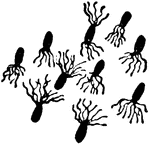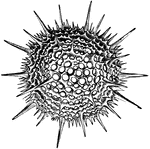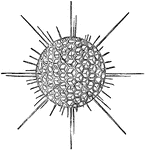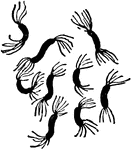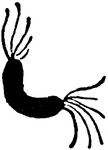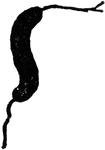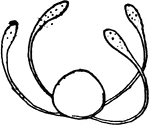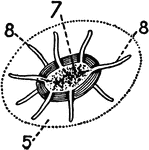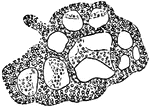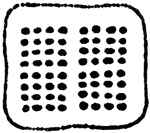The Microorganisms gallery offers 177 images of microbiology and several types of microorganisms. Microorganisms, also known as microbes, are organisms that are microscopic, and are usually too small to be seen by the naked human eye.
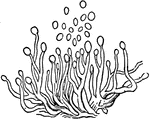
Pycnides
"Pycnides of Peltigera rufescens. a, basidia; b, stylospores." —The Encyclopedia Britannica, 1910

Radiolarian
"Optical section of a Radiolarian. a, Nucleus; b, wall of central capsule; c, siliceous shell within…
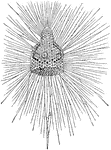
Radiolarian
A modern Radiolarian, showing the skeletal structure of silica and the extended fleshy threads or pseudopodia.
Rodlet
"A motile rodlet with one cilium and with a spore formed inside." — The Encyclopedia Britannica,…

Rotalia
One group will take the spherical form and produce a shell in the shape of the nautilus. Some are more…
Rotifer
Rotifers are free-swimming pseudo-coelomates. They occur in freshwater and are easily examined because…

Rotifer
The rotifer or "wheel animalcule" owes its name to the fact that the anterior end of the body is almost…

Rotifer
The rotifer or "wheel animalcule" owes its name to the fact that the anterior end of the body is almost…

Rotifer
This diagram shows a sagittal section of a Rotifer. b, brain; bl., excretory bladder; c, cloaca, the…

Rotifer
A rotifer or wheel animalcule (Floscularia ornata) is a microscopic animal named for the cilia used…
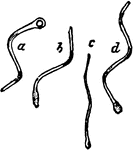
Schizomycetes
"Spore-formation in Vibrio-like (c) and Spirillum-like (a, b, d) Schizomycetes." — The Encyclopedia…

Spermatozoa
"Types of spermatozoa. A, from the round worm (Ascaris) with a cap, somewhat amaeboid; B, from the Crayfish,…

Spirillum
"Spirillum containing many spores (a), which are liberated at b by the breaking up of the parent cells."…

Spiroloculina Depressa
One group will take the spherical form and produce a shell in the shape of the nautilus. Some are more…
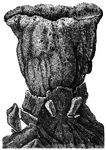
Sponge Attached to its Rocky Bed
"The pores of sponges are of two kinds, the larger ones called 'oscula'" and the smaller distinguished…
Spore
"Long rod-like form containing a spore (these are the so-called "Kopfchenbacterien" of German authors)."…
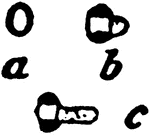
Spore
"Germination of the spore of the hay bacillus—the axis of growth of the germinal rodlet is at…
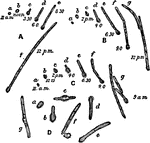
Sporegerm
"The various phases of germination of spore of Bacillus ramosus, as actually observed in hanging…

Spores
"Various stages in the development of the endogenous spores in a Clostridium — the small letters…

Summer Spores (Uredospores) on Wheat
These are very destructive parasites that attack valuable crops. Rusty lines and dots appear on the…

Textularia Variabilis
One group will take the spherical form and produce a shell in the shape of the nautilus. In this case,…
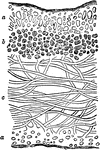
Thallus
"Section of Stratified Thallus of Ricasolia herbacea. a, cortical stratum; b, gonidial stratum; c, medullary…

Thallus
"Section of Unstratified Thallus of Collema conglomeratum, with Moniliform Gonimia scattered amongst…

Trypanosoma Gambiense
"1. Trypanosoma gambiense, showing nucleus, blepharoplast, and flagellum. 2 and 3. Individuals undergoing…

Tumbler
A tumbler containing a piece of potato. It is covered with cotton. This is used to grow bacteria.
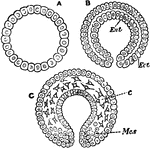
Unilaminar
"Sections through the unilaminar (A), bilaminar (B), and trilaminar (C) conditions of the typical biastoder.…
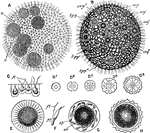
Volvox Globator
"Volvox globator. A, entire colony, enclosing several daughter-colonies; B, the same during sexual maturity;…

Volvox Globular
"The common Volvox is found in great abundance during the summer, and even in the depth of winter in…

Volvox Globular
"The common Volvox is found in great abundance during the summer, and even in the depth of winter in…

Vorticella
"Vorticella. 1. Structure. N., Macronucleus; n., micronucleus; c.v., contractile vacuole; m., mouth;…

Vorticella
"A, Vorticella, a stalked ciliate Infusorian; I, contracted; 2, extended. f, food "vacuoles"; g, gullet;…

Vorticella
"Vorticella. A, B, living specimens in different positions; C, optical section; D1, D2, diagrams illustrating…

Water Bear
"A water-Bear, or Bear-animalcule (Macrobiotus schultzei), one of the Arctisca or Tardigradam, much…

Winter Spores (teleutospores) on Wheat
These are very destructive parasites that attack valuable crops. Black lines and dots appear on the…

Wolffiella
Plants floating just below water surfacel plant body made up of a clump of short filaments.
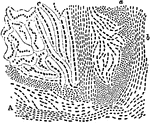
Zoogloea
"Mixed zoogloea found as a pellicle on the surface of vegetable infusions; it consists of various forms,…
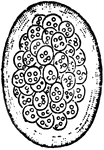
Zoogloea
"Egg-shaped mass of zoogloea of Beggiatoa roseo-persicina (Bacterium rubescens of Lankster); the gelatinous…
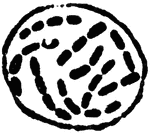
Zoogloea
"Zoogloea of Bacterium merismopedioides, Zopf, containing cocci arranged in tablets." — The Encyclopedia…

Types of Zoogloea
"A. Mixed Zoogloea found as a pellicle on the surface of vegetable infusions &c; it consists of various…
